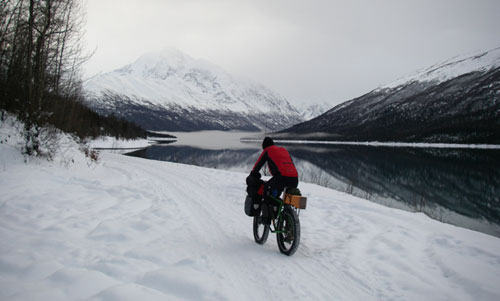Sub-Zero Cycling

“If you don’t come down now, the bus is leaving without you.” At 9.58, this was my introduction to Bill Merchant’s sense of humour. He was meeting us at 10.00 for his winter riding school. This is not British winter that we’re being schooled on, it’s Alaskan winter and we’re training for the Iditarod Trail Invitational. A 350 mile race across frozen lakes, rivers, and mountains with minimal support and maximum responsibility for the racers. The minimalist approach allows us to experience the total freedom of the wilderness. We can decide when and where to sleep, how much to carry, even where to go as long as we hit each of the checkpoints. All we need to do is be capable of looking after ourselves in temperatures that could reach -40°C, be ready to push for hundreds of miles (if that’s what the weather serves up), and be dumb enough to think the whole thing is a good idea in the first place.
I have a bit of background in endurance racing in the UK with solo 6, 8, 10, 12, and 24 hour races under my belt. Even so, this was an intimidating goal to aim for. Many seasoned endurance racers have come here and failed, beaten by the elements or by their own heads. So, I decided that I should test myself and my gear against the real conditions before I line up at the start. With Bill and Kathi (who rode the 1,100 mile version of the race this year) as teachers, I’d be bound to learn many valuable lessons.
The learning began from the second I got into Bill’s van. He has gathered so many stories from personal experience and from other racers out here that he has no need to sit down and tell you what to do. The stories come out and entertain, informing along the way and giving substance to the techniques. Different racers do things different ways and understanding their motivations can help you to figure what will work for you. For example, some people like to load their bike up evenly, some like it front-heavy. My mountain bike background made me favour the latter. For me, weight over the front means control and body-shifting can deal with rear wheel traction. We could talk about every little detail of set-up and test our decisions in the real world and against the experience of Bill and Kathi.
In this particular bit of the real world, getting the hang of riding on snow is fundamental. To imagine what it’s like, start off by assuming it’s a slippery layer of mud on top of a somewhat firm surface. That’s the good rideable snow. The deep stuff is like the deepest sloppiest mud you’ve ever seen (but cleaner). Riding a fat bike (with 4in wide, low pressure tyres) in snow makes the experience a lot of fun, though. If conditions are favourable, you can go pretty well. The massive tyres give you more control than you would otherwise have, allowing you to float on top, rather than sink into the snow. On good trails with packed-down snow from snowmobiles or skiers, you can make a whopping 10 km/h.

